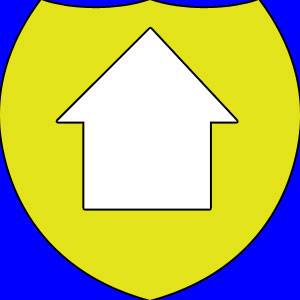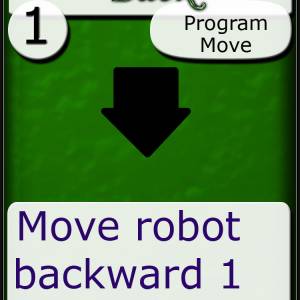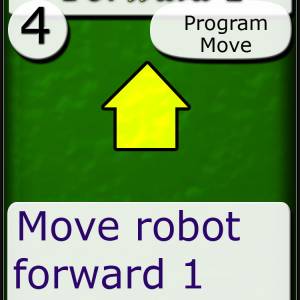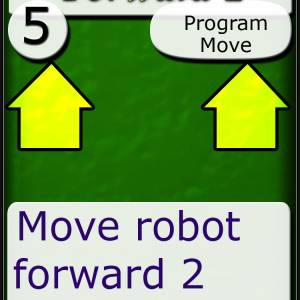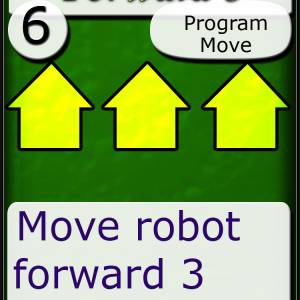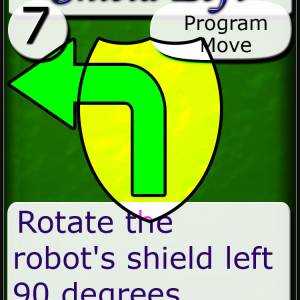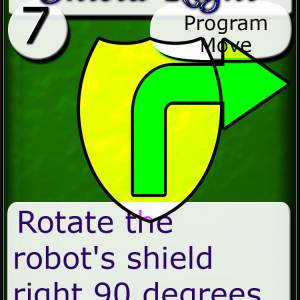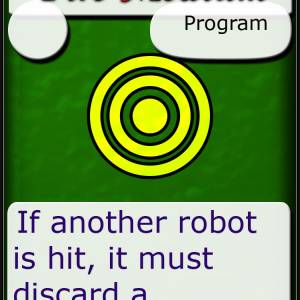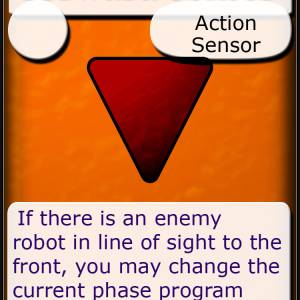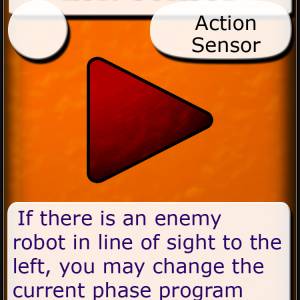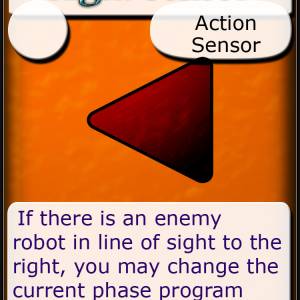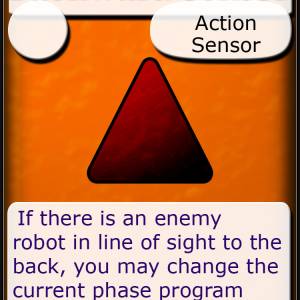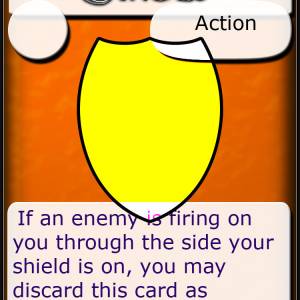Table of Contents
Battle Bots v2

This work is licensed under a
Creative Commons Attribution-NonCommercial-ShareAlike 2.5 License.
Boardgame Geek page
Summary
The concept behind this game is the programming of warrior robots that fight each other. Each robot comes equipped with 4 sensors, a rotating ablative shield and a turret mounted laser.
Inspired by Robo Rally
Number of Players: 2+
Type of Game: Abstract Tactical
Components
Board
The board is any square grid. It may have hazards and walls. Roborally boards can be used and all normal rules for board elements in that game are compatible.
The size of the board is dependant on the number of players-
- 2-3 Players = 6×6 Board
- 4-6 Players = 10×10 Board
- 8-20 Players = 15×15 Board (or 20×10 Board)
Board Variants
- King of the Hill—The board contains no walls. In the middle of the board is a repair station. Any robot that ends phase 5 on top of the repair station may retrieve a card of their choice from their discards and put it back into their hand.
Pieces
The only pieces used in this game are-
- a robot model for each player.
- a shield marker for each player to show the current facing of their shield.
Cards
Cards have two purposes in this game-
- To program a player's robot
- To record damage
There are two types of cards in the game-
- Turn programmed cards, which are placed at the beginning of a turn.
- Action cards, which are played during a phase.
Setup
- Each player starts with the same deck of 22 cards at the beginning of a game. Cards are gradually discarded as a robot takes damage.
- Place each robot on the board out of line of sight of any other robot and at least 10 squares away.
- The winner of the last game places their robot first. Otherwise determine order randomly.
Playing
Each turn consists of two parts - the programming round and the action round. The action round is broken into 5 phases.
- One Turn
- Programming Round
- Each player places up to five cards in front of them face down in sequential order.
- These cards must be program cards and not action cards.
- If placing less than five cards (if for example, you don't have many left) it must be obvious which spaces you are leaving empty. Robots that do not have a programming card for a phase do nothing (but can be interrupted with an action card as normal).
- Action Round
- Phase 1
- Any robot that has another robot within line of sight orthogonally (forward, backward, left or right) and has the appropriate sensor card, may play that card and change their program card for the phase with a different program card in their hand.
- Played Sensor cards are put to one side until the end of the turn, and are then put back in the player's hand.
- Each player turns their first card over (if they have one) and moves their robot according to that card.
- In the case of conflict, the card with the higher initiative goes first. If that isn't possible then the player with the least damage moves first. Otherwise the players should determine randomly who moves first.
- No robot can enter the same square as another robot. It will push them if it can, otherwise it doesn't move.
- Ramming a robot (even if it doesn't get moved) causes 1 program card damage to the robot for each square that the ramming robot has moved that phase (1-3).
- Ramming a robot into a wall (even if it doesn't get moved) causes an additional 1 program card damage.
- Any player may play an action card at any time in a phase if it is applicable. Some action cards must be discarded after use - usually this is because they absorb damage.
- Redirect Shield Energy into Sideways Momentum—Any player may discard a Shield card as an action to move their robot sideways (either left or right). They may discard multiple cards to move multiple squares.
- Board elements affect robots.
- Robots that have a programmed fire action may fire at one target in line of sight orthogonally. The turret may face any direction (forward, backward, left or right), but may only fire once per phase.
- If a robot is hit by a weapon and it has a shield facing the direction the attack came from, the player may discard a shield action card instead of any other kind of card as damage.
- Phase 2
- As Phase 1
- Phase 3
- As Phase 1
- Phase 4
- As Phase 1
- Phase 5
- As Phase 1
- Logistics
- Each player retrieves any sensor cards they played this turn.
Damaging a Robot
If you must discard a card from your hand, place it face up in front of you in such a way that all other players can see which cards you may no longer use.
- If playing a timed game, then discarded cards go to the player that damaged you and are used as their final score instead.
You may choose to discard a card that is currently in use in your program for the turn.
If you are unable to discard a card, because you have no suitable cards (ie a Fire High on a side you have already lost sensors) - you do not need to discard any card.
Destroying Robots
The first kill of the game is worth as many victory points as there are players in the game.
The second and subsequent kills are worth one point less than the previous kill.
- A robot is destroyed if it has no program cards left. Victory points are awarded to the player that destroyed the robot.
- If more than one player destroyed the robot, the points are divided amongst them (rounded down).
- If two robots destroy each other at the same time, the points for that kill, and the next kill are added together, and divided amongst the players (rounded down).
- A robot is destroyed if it self destructs. No victory points are given to any player.
- A robot is destroyed by some board elements. No victory points are given to any player.
Crushing Walls
After the first robot has been destroyed, the walls of the arena begin to crush the remain robots. Each turn after the first kill the board loses one outer row and one outer column. All robots in that row or column are pushed in to the next innermost row or column.
- If a robot is crushed between the arena wall and an inner wall, it is destroyed and earns no victory points to anyone.
- The player of the robot most recently destroyed decides which of the two choices for row (top or bottom) and for column (left or right) are moved inward.
A Player's Deck
| Name | Initiative | Type | Description | |
|---|---|---|---|---|
| 1 | Back | 1 | Program, Move | Move robot backward 1 square |
| 2 | Left | 2 | Program, Move | Rotate robot left 90 degrees |
| 3 | Right | 2 | Program, Move | Rotate robot right 90 degrees |
| 4 | U Turn | 3 | Program, Move | Rotate robot 180 degrees |
| 5 | Forward 1 | 4 | Program, Move | Move robot forward 1 square |
| 6 | Forward 2 | 5 | Program, Move | Move robot forward 2 squares |
| 7 | Forward 3 | 6 | Program, Move | Move robot forward 3 squares |
| 8 | Move Shield Left | 7 | Program, Move | Rotate the robot's shield left 90 degrees |
| 9 | Move Shield Right | 7 | Program, Move | Rotate the robot's shield right 90 degrees |
| 10 | Fire High | N/A | Program | If another robot is hit, it must discard the Sensor card that faces your robot |
| 11 | Fire Medium | N/A | Program | If another robot is hit, it must discard a Program card |
| 12 | Fire Low | N/A | Program | If another robot is hit, it must discard a Move card |
| 13 | Forward Sensors | N/A | Action, Sensor | If there is an enemy robot in line of sight to the front, you may change the current phase program card. You may only use this card once per turn. |
| 14 | Left Sensors | N/A | Action, Sensor | If there is an enemy robot in line of sight to the left you may change the current phase program card. You may only use this card once per turn. |
| 15 | Right Sensors | N/A | Action, Sensor | If there is an enemy robot in line of sight to the right you may change the current phase program card. You may only use this card once per turn. |
| 16 | Backward Sensors | N/A | Action, Sensor | If there is an enemy robot in line of sight to the back, you may change the current phase program card. You may only use this card once per turn. |
| 17 | Shield | N/A | Action | If an enemy is firing on you through the side your shield is on, you may discard this card as damage instead of any other card. May also be discarded to move sideways. |
| 18 | Shield | N/A | Action | If an enemy is firing on you through the side your shield is on, you may discard this card as damage instead of any other card. May also be discarded to move sideways. |
| 19 | Shield | N/A | Action | If an enemy is firing on you through the side your shield is on, you may discard this card as damage instead of any other card. May also be discarded to move sideways. |
| 20 | Shield | N/A | Action | If an enemy is firing on you through the side your shield is on, you may discard this card as damage instead of any other card. May also be discarded to move sideways. |
| 21 | Shield | N/A | Action | If an enemy is firing on you through the side your shield is on, you may discard this card as damage instead of any other card. May also be discarded to move sideways. |
| 22 | Self Destruct | N/A | Action | If you have fewer than 7 cards left you may play this card to destroy your robot. Robots suffer program card damage if they are within 3 squares of your robot. Adjacent = 4, 1 away = 2, 2 away = 1 damage. |
Winning the Game
Winning through Points
The game is won by achieving enough victory points.
- If a player achieves a score equal to 1.5 times the number of players in the game (rounded down), they win.
- If there is only one robot left and no player has achieved the necessary total, the player with the most points wins.
Timed Winning
The game is won by the player that has caused the most damage in the game.
- Whenever a player's robot damages another, that player keeps the discard of the robot as a score card.
- When the predetermined time for the game to end (either number of turns or time of day) - the players count the cards they have from others,
- The player with the largest amount of discards from others wins.
Variants
A player may customize their robot with one (and only one) of the following variants-
- Heavy Shield—Remove both Move Shield cards from your deck. Add 4 more Shield cards. Choose which direction your shield is fixed in - it does not move for the entire game.—More shield generators have been added to your robot, making the focus too heavy to rotate.
- Light Shield—Remove two Shield cards from your deck. Your Move Shield cards may now rotate your shield up to 180 degrees.—Removing shield generators have enabled the focal armature to move twice as fast.
- Big Gun—Your laser may now only fire in the same direction as your shield. However it now does twice the amount of damage.—A larger gun has been added, but because of its weight it can only rotate with the additional support of the shield focal armature.
- Energy Leech—Your laser now converts shield damage for your use. Remove the Forward 2 and Forward 3 cards from your deck. Whenever you damage another robot's shield - take their shield card into your hand. You may expend shield cards to move forward - 1 space per card expended (discarded) in a phase. There is no limit to the amount of cards that may be expended in a phase.—Motors have been coupled to a shield discharge capacitor focused through your robot's laser.
- Rammer—Discard two of your Fire cards (your choice). All Forward cards now move an additional 1 space.—Lightening the laser by removing attitude motors has increased the speed of your robot.

